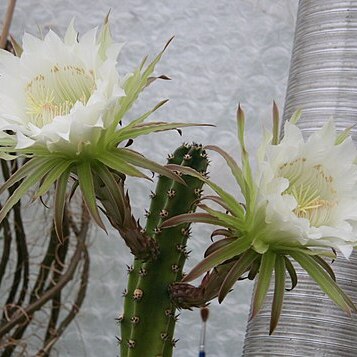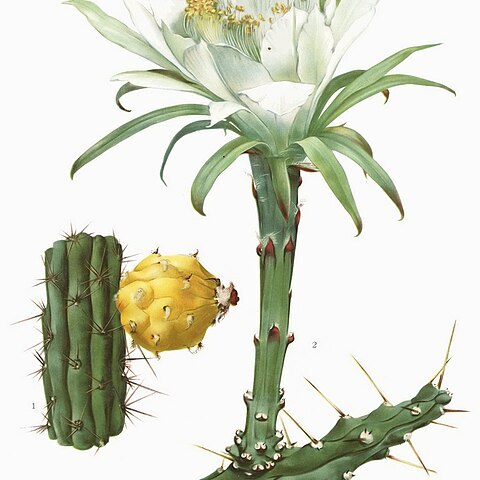Succulent shrubs, some tree-like (not in Australia), sparingly branched or unbranched, up to 7 m high. Stems erect, prostrate or arching, clambering or climbing, usually slender, ribbed, unsegmented, long-cylindric, glabrous, green to glaucous, without aerial roots. Ribs 3–12 (rarely absent), continuous or discontinuous, tuberles low or absent. Areoles borne on rib prominences or on tubercles, c. 2 cm apart along ribs, circular to oval, woolly. Leaves deltoid, 0.5–1.1 mm long, caducous. Spines 6–17 per areole, usually porrect to ascending, white to pinkish or yellow to light brown, ageing grey, sometimes with tips darker or yellowish, acicular, straight, ± terete. Flowers lateral and terminal, funnelform, white, nocturnal. Pericarpel and hypanthium areolate, bearing small triangular scales, mostly with hair-like spines or wool; pericarpal green to purplish red, with deltoid to lanceolate scales, often tuberculate; hypanthium slender, elongate, green to brown to red, scales green to brown to red, rounded-truncate and somewhat erect basally, deltoid to lanceolate, acute to subulate at the apex. Outer tepals ensiform to lanceolate or narrowly oblong, green to reddish or purplish. Inner tepals lanceolate or spathulate to narrow-obovate, with slender limb, margins roughened-entire to irregularly denticulate, white to pinkish. Stamens numerous, adnate to inner hypanthium, arrangement bilaterally symmetrical with a dense group of stamens in the lower portion of the flower (the abaxial stamen cluster and lower rim stamens) and few in the upper portion (the upper rim stamens); staminal filaments basally light green, white distally, anthers beige or pale yellow. Style exserted beyond to sometimes level with the anthers. Fruits fleshy, globose, ovoid or ellipsoid, yellow or orange and indehiscent (subgen. Harrisia, not in Australia), or red and splitting irregularly from apex toward base (subgen. Eriocereus), usually spineless, scales deciduous or sometimes persistent, pulp white, withered perianth usually persistent. Seeds broadly ovoid to broadly ellipsoid, tuberculate or reticulate-papillate, with deeply impressed hilum areas forming chambers.
More
Shrubs, often treelike, erect or old plants with branches usually ascending, clambering, or prostrate, sparingly branched or unbranched. Roots diffuse (sometimes tuberlike). Stems unsegmented, green, long cylindric, 100-600 × 2.5-6 cm, glabrous; ribs 8-12, rounded, low, less than 1 cm deep, shallowly to indistinctly tuberculate; areoles ca. 2 cm apart along ribs, circular to oval, short woolly, sometimes subtended by small, subulate, deciduous leaves; areolar glands not apparent; cortex and pith mucilaginous. Spines 6-17 per areole, usually porrect to ascending, white to pinkish or yellow to light brown, aging gray, sometimes with tips darker or yellowish, acicular, straight, ± terete, 10-40 × 0.5-0.75[-1.5] mm, hard, smooth and glabrous; radial spines and central spines not clearly distinguishable. Flowers nocturnal, remaining open next day, lateral or terminal on stems at least 1 year old, funnelform, 12-20[-25] × 8-12 cm; outer tepals green to reddish or purplish, linear to lanceolate or narrowly oblong, 50-60 × 4.5-6 mm, margins entire; inner tepals white to pinkish, 60-75 × 12-20 mm, margins entire or denticulate; ovary usually conspicuously tuberculate, scaly, spineless or spines represented by soft and silky to stiff hairs [or spiny]; scales entire; stigma lobes 8-15, yellow-green to white, 6-9 mm. Fruits indehiscent or splitting irregularly from apex toward base, green to yellow, red, or orange-red, spheric to ovoid-spheric, [30-]40-75[-80] × [30-]40-75[-80] mm, usually spineless (or spines bristlelike) [or slender acicular]; scales deciduous [sometimes persistent]; pulp white; floral remnant usually persistent. Seeds black, broadly ovoid or broadly ellipsoid, 2-3 × 1.5 mm, warty. x = 11.


